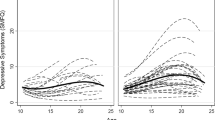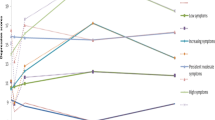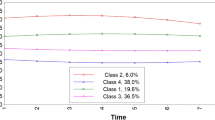Abstract
Two common approaches for studying trajectories of change are standard growth curve modeling (GCM) and latent class growth modeling (LCM) (Singer and Willett, Applied longitudinal data analysis. Modeling change and event occurrence. Oxford University Press, New York, 2003; Nagin, Group-based modeling of development. Harvard University Press, Cambridge, 2005). The objectives were to compare the results obtained using GCM and LCM in modeling trajectories of depressive symptoms in a sample of mothers of children with epilepsy; compare the methods in predicting average trajectory and individual trajectories, and; provide general guidelines for implementing these approaches. Findings from the two modeling strategies were different: GCM suggested a quadratic change in depressive symptoms over time. Addition of the time-varying covariate, family functioning, produced a final model that explained 25, 20, 31, and 18% of the residual intra-individual, as well as inter-individual variation in the intercept and slope (linear, quadratic), respectively. Results from the LCM suggested five distinct trajectories of depressive symptoms: low stable (30%), sub-clinical (39%), moderate decreasing (15%), moderate increasing (9%), and high decreasing (7%). Adding the family functioning variable resulted in a model that replaced the sub-clinical trajectory with borderline and moderate decreasing with high increasing. Both the GCM and LCM adequately described the average trajectory of maternal depressive symptoms with signed differences of 0.61 and 0.75 and −2.39 and −2.54 for the unconditional and conditional models, respectively. There was considerable variation in capturing individual trajectories. For approximately 14 and 9% of individuals, both models under and overestimated depression scores by at least five points. Although GCM and LCM perform equally well in predicting average and individual trajectories of change, they are used most efficiently under different circumstances. Where individuals are expected to share a homogeneous trajectory, GCM should be used; however, where individuals do not follow a common trajectory, LCM is more appropriate.




Similar content being viewed by others

Notes
Fitting a quadratic model allowed for both the intercept and slope parameters to be estimated as fixed and random effects. In order to fit a cubic model, at least one of the estimate parameters (i.e., intercept, linear, quadratic, or cubic) must be fixed to allow for a degree of freedom. For each case, BIC values indicated worse model fit compared to quadratic model presented and thus were not used in this analysis.
References
Bonanno, G.A.: Loss, trauma, and human resilience: have we underestimated the human capacity to thrive after extremely aversive events? Am. Psychol. 59, 20–28 (2004)
Bryk, A.S., Raudenbush, S.W.: Application of hierarchical linear models to assessing change. Pyschol. Bull. 101, 147–158 (1987)
Buckingham-Howes, S., Oberlander, S.E., Hurley, K.M., Fitzmaurice, S., Black, M.M.: Trajectories of adolescent mother-grandmother psychological conflict during early parenting and children’s problem behaviors at age 7. J. Clin. Child. Adolesc. Psychol. 40, 445–455 (2011)
Bushway, S.D., Sweeten, G., Nieuwbeerta, P.: Measuring long term individual trajectories of offending using multiple methods. J. Quant. Criminol. 25, 259–286 (2009)
Cambron, M.J., Acitelli, L.K., Steinberg, L.: When friends make you blue: the role of friendship contingent self-esteem in predicting self-esteem and depressive symptoms. Pers. Soc. Psychol. Bull. 36, 384–397 (2010)
Campbell, S.B., Morgan-Lopez, A.A., Cox, M.J., McLoyd, V.C.: A latent class analysis of maternal depressive symptoms over 12 years and offspring adjustment in adolescence. J. Abnorm. Psychol. 118, 479–493 (2009)
Curran, P.J., Muthen, B.O.: The application of latent curve analysis to testing developmental theories in intervention research. Am. J. Commun. Psychol. 27, 567–595 (1999)
Dolgin, M.J., Phipps, S., Fairclough, D.L., Sahler, O.J., Askins, M., Noll, R.B., Butler, R.W., Varni, J.W., Katz, E.R.: Trajectories of adjustment in mothers of children with newly diagnosed cancer: a natural history investigation. J. Pediatr. Psychol. 32, 771–782 (2007)
Elgar, F.J., Mills, R.S., McGrath, P.J., Waschbusch, D.A., Brownridge, D.A.: Maternal and paternal depressive symptoms and child maladjustment: the mediating role of parental behavior. J. Abnorm. Child Psychol. 35, 943–955 (2007)
Ferro, M.A., Avison, W.R., Campbell, M.K., Speechley, K.N.: Prevalence and trajectories of depressive symptoms in mothers of children with newly-diagnosed epilepsy. Epilepsia 52, 326–336 (2011a)
Ferro, M.A., Avison, W.R., Campbell, M.K., Speechley, K.N.: The impact of maternal depressive symptoms on health-related quality of life in children with epilepsy: a prospective study of family environment as mediators and moderators. Epilepsia 52, 316–325 (2011b)
Gump, B.B., Reihman, J., Stewart, P., Lonky, E., Darvill, T., Granger, D.A., Matthews, K.A.: Trajectories of maternal depressive symptoms over her child’s life span: relation to adrenocortical, cardiovascular, and emotional functioning in children. Dev. Psychopathol. 21, 207–225 (2009)
Herr, N.R., Hammen, C., Brennan, P.A.: Current and past depression as predictors of family functioning: a comparison of men and women in a community sample. J. Fam. Psychol. 21, 694–702 (2007)
Hughes, S., Cohen, D.: A systematic review of long-term studies of drug treated and non-drug treated depression. J. Affect. Disord. 118, 9–18 (2009)
Jones, B.L., Nagin, D.S.: Advances in group-based trajectory modeling and a SAS procedure for estimating them. Soc. Methods Res. 35, 542–571 (2007)
Kass, R.E., Wasserman, L.: A reference Bayesian test for nested hypotheses and its relationship to the Schwarz criterion. J. Am. Stat. Assoc. 90, 928–934 (1995)
Lim, J., Wood, B.L., Miller, B.D.: Maternal depression and parenting in relation to child internalizing symptoms and asthma disease activity. J. Fam. Psychol. 22, 264–273 (2008)
Lo, C., Zimmerman, C., Rydall, A., Walsh, A., Jones, J.M., Moore, M.J., Shepherd, F.A., Gagliese, L., Rodin, G.: Longitudinal study of depressive symptoms in patients with metastatic gastrointestinal and lung cancer. J. Clin. Oncol. 28, 3084–3089 (2010)
Marmorstein, N.R.: Longitudinal associations between depressive symptoms and alcohol problems: the influence of comorbid delinquent behavior. Addict. Behav. 35, 564–571 (2010)
Mazza, J.J., Fleming, C.B., Abbott, R.D., Haggerty, K.P., Catalano, R.F.: Identifying trajectories of adolescents’ depressive phenomena: an examination of early risk factors. J. Youth Adolesc. 39, 579–593 (2010)
Nagin, D.S.: Analyzing developmental trajectories: a semiparametric, group-based approach. Psychol. Methods 4, 139–157 (1999)
Nagin, D.S.: Group-based modeling of development. Harvard University Press, Cambridge (2005)
Nagin, D.S., Tremblay, R.E.: What has been learned from group-based trajectory modeling? Examples from physical aggression and other problem behaviors. Ann. Am. Acad. Pol. Soc. Sci. 602, 82–117 (2005a)
Nagin, D.S., Tremblay, R.E.: Further reflections on modeling and analyzing developmental trajectories: a response to Maughan and Raudenbush. Ann. Am. Acad. Pol. Soc. Sci. 602, 145–154 (2005b)
Radloff, L.S.: The CES-D scale: a self-report depression scale for research in the general population. Appl. Psychol. Meas. 1, 385–401 (1977)
Raudenbush, S.W.: Comparing personal trajectories and drawing causal inferences from longitudinal data. Annu. Rev. Psychol. 52, 501–525 (2001)
Raudenbush, S.W.: How do we study “what happens next”? Ann. Am. Acad. Pol. Soc. Sci. 602, 131–144 (2005)
Sawyer, M., Antoniou, G., Toogood, I., Rice, M., Baghurst, P.: Childhood cancer: a 4-year prospective study of the psychological adjustment of children and parents. J. Pediatr. Hematol. Oncol. 22, 214–220 (2000)
Schwarz, G.: Estimating dimensions of a model. Ann. Stat. 6, 461–464 (1978)
Singer, J.D.: Fitting individual growth models using SAS PROC MIXED. In: Moskowitz, D.S., Hershberger, S.L. (eds.) Modeling intraindividual variability with repeated measures data: methods and applications. Lawrence Erlbaum, Mahwah (2002)
Singer, J.D., Willett, J.B.: Applied longitudinal data analysis. Modeling change and event occurrence. Oxford University Press, New York (2003)
Smilkstein, G.: The family APGAR: a proposal for a family function test and its use by physicians. J. Fam. Pract. 6, 1231–1239 (1978)
Smilkstein, G., Ashworth, C., Montano, D.: Validity and reliability of the family APGAR as a test of family function. J. Fam. Pract. 15, 303–311 (1982)
Weiss, R.E.: Modeling longitudinal data. Springer, New York (2005)
Wickrama, T., Wickrama, K.A.S.: Heterogeneity in adolescent depressive symptom trajectories: implications for young adults’ risky lifestyle. J. Adolesc. Health 47, 407–413 (2010)
Wyrwich, K.W., Tierney, W.M., Wolinsky, F.D.: Further evidence supporting an SEM-based criterion for identifying meaningful intra-individual changes in health-related quality of life. J. Clin. Epidemiol. 52, 861–873 (1999)
Acknowledgments
We gratefully acknowledge the parents and physicians and their staff, without whose participation, HERQULES would not have been possible. The Canadian Paediatric Epilepsy Network effectively facilitated the participation of physicians across the country. The authors extend special thanks to Dr. Guangyong Zou for his helpful suggestions in preparing this manuscript. Mark A. Ferro was the recipient of a Canadian Institutes for Health Research, Frederick Banting and Charles Best Canada Graduate Scholarship Doctoral Award. Kathy N. Speechley was the recipient of a Canadian Institutes for Health Research operating grant for HERQULES (MOP-64311). We confirm that we have read the Journal’s position on issues involved in ethical publication and affirm that this report is consistent with those guidelines.
Conflict of interest
None of the authors has any conflict of interest to disclose.
Author information
Authors and Affiliations
Corresponding author
Rights and permissions
About this article
Cite this article
Ferro, M.A., Speechley, K.N. Depressive symptoms in mothers of children with epilepsy: a comparison of growth curve and latent class modeling. Health Serv Outcomes Res Method 12, 44–61 (2012). https://doi.org/10.1007/s10742-012-0081-2
Received:
Revised:
Accepted:
Published:
Issue Date:
DOI: https://doi.org/10.1007/s10742-012-0081-2



